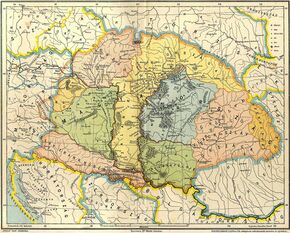Place:Duchy of Pannonian Croatia
This article duplicates the scope of other articles, specifically, Lower Pannonia (9th century). (October 2017) |
The factual accuracy of part of this article is disputed. The dispute is about Lower Pannonia≠Pannonian Croatia. (October 2017) (Learn how and when to remove this template message) |
Duchy of Pannonian Croatia Kneževina Panonska Hrvatska Kneževina Slavonija | |||||||||
|---|---|---|---|---|---|---|---|---|---|
| 7th century–10th century | |||||||||
 Duchy of Pannonian Croatia (peach coloured) under Braslav in the 9th century on an old map of Hungarian historian Dr. Márki Sándor | |||||||||
| Capital | Sisak | ||||||||
| Common languages | Old Croatian | ||||||||
| Religion | Christianity | ||||||||
| Government | Duchy | ||||||||
| Historical era | Middle Ages | ||||||||
• Established | 7th century | ||||||||
• Disestablished | 10th century | ||||||||
| |||||||||
| Today part of | Croatia Bosnia and Herzegovina Slovenia Hungary Serbia | ||||||||
The Duchy of Pannonian Croatia (Croatian: Kneževina Panonska Hrvatska) is a name used in Croatian historiography for a medieval Slavic duchy from the 7th to the 10th century located in the Pannonian Plain approximately between the rivers Drava and Sava in today's Croatia.[1] At times, the duchy extended considerably to the south of the Sava, encompassing most of its basin. Its political center was in Sisak.
History
Slavs came to the territory of the former Roman province Pannonia in the late 6th and early 7th century, as evidenced by many archeological finds. According to De administrando imperio, at the time of the rule of Emperor Herakleios (610–640), Croats arrived in Dalmatia, founded a duchy there and, shortly afterward, a part of them went to the north to Pannonia and founded another duchy there (Pannonian Croatia).
In the late 7th century or in the 8th century, the Duchy became vassalaged to the Avar Empire, as archaeological finds suggest.[citation needed] After the defeat of the Avar Empire by Frankish troops, Duke Vojnomir was assigned the Duchy as a vassal of the Frankish margrave of Friuli.[2][better source needed] The Duchy failed to end Frankish domination during a rebellion under Duke Ljudevit Posavski in the early 9th century.
In 827, the Bulgarians invaded and conquered the Duchy and parts of territories to the north of it. In 829 they imposed a local Duke Ratimir as the new ruler of Pannonian Croatia in their name.[citation needed] The Franks however claimed the territory, which in their view belonged (since 827) to the March of Carantania and thus under the rule of Count Ratbod[dubious ], who had been head of the Avar March and March of Carantania since 828.
In 838, Ratbod deposed Ratimir and subordinated the Duchy to the Frankish March of Carantania. Another known ruler of Pannonian Croatia was Braslav, who ruled there in 880–898 or 900, still vassalaged to the Kingdom of East Francia.
In the 10th century, under Duke (later King) Tomislav, the Duchy of Pannonian Croatia might have been united with Littoral Croatia to form the Kingdom of Croatia.[3] The sources of the extent of Tomislav's kingdom are however conflicting.
Rulers
- Vojnomir (c. 790–c. 800 or 791–c. 810)
- Ljudevit Posavski (810–823)
- Ratimir (829–838)
- Braslav (880–c. 887 or 900)
See also
- Medieval Croatian state
- Dukes of Croatia
- Duchy of Croatia
- Kingdom of Croatia
References
- ↑ Hrvoje Gračanin, "Od Hrvata pak koji su stigli u Dalmaciju odvojio se jedan dio i zavladao Ilirikom i Panonijom : Razmatranja uz DAI c. 30, 75-78", Povijest u nastavi, Vol.VI No.11 (1) Lipanj 2008, p. 74
- ↑ Mediaeval Academy of America (1945). Speculum. University of California. p. 230. https://books.google.hr/books?ei=_2mWTL65NJiT4gaxpuGBBA&ct=result&id=_BQbAAAAIAAJ&dq=Erich+of+Friuli&q=Croatian.
- ↑ Opća enciklopedija JLZ. Zagreb. 1982.
External links
- The Duchy of Pannonian Croatia was established between Sava and Drava Rivers
- Northern Pannonian Croatia was ruled by dukes
- Map of Pannonian and Dalmatian Croatia
- Map - Pannonian Duchy in the time of Ljudevit
- Map - Pannonian Principality in the time of Braslav

